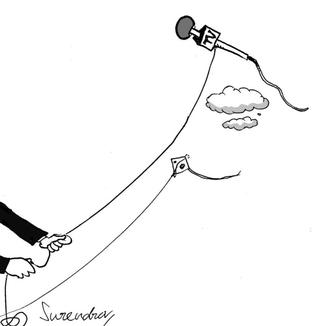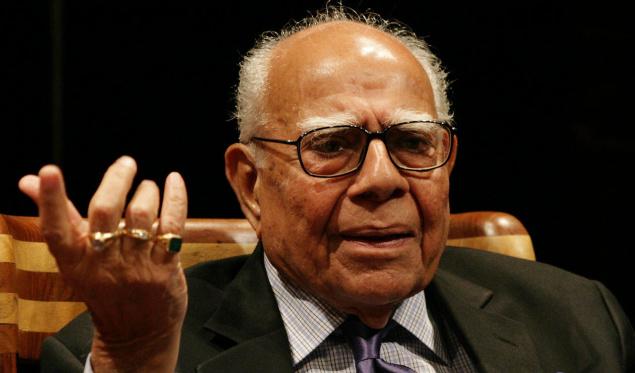JUSTICE MARKANDEY KATJU IN THE HINDU
If red lines can be drawn for the legal and medical professions, why should it be any different for profit-making newspapers and TV channels?
I have not read the Private Member’s Bill on media regulation that Meenakshi Natarajan was scheduled to move in Parliament last week so I am not in a position to comment upon it, but I am certainly of the opinion that the media (both print and electronic) needs to be regulated. Since my ideas on this issue have generated some controversy they need to be clarified.
I want regulation of the media, not control. The difference between the two is that in control there is no freedom, in regulation there is freedom but subject to reasonable restrictions in the public interest. The media has become very powerful in India and can strongly impact people’s lives. Hence it must be regulated in the public interest.
The media people keep harping on Article 19 (1) (a) of the Indian Constitution which guarantees the freedom of speech and expression. But they deliberately overlook or underplay Article 19 (2) which says that the above right is subject to reasonable restrictions in the interest of sovereignty and integrity of India, State security, public order, decency, morality or in relation to defamation or incitement to an offence.
Not absolute
Thus, while there should be freedom for the media and not control over it, this freedom must be exercised in a manner not to adversely affect the security of the state, public order, morality, etc. No right can be absolute, every right is subject to reasonable restrictions in the public interest. The reason for this is that human beings are social creatures. No one can live in isolation, everyone has to live in society. And so an individual should not exercise her freedom in a manner so as to harm others or society, otherwise she will find it difficult to survive.
Media people often talk of self-regulation. But media houses are owned by businessmen who want profit. There is nothing wrong in making profits, but this must be coupled with social responsibilities. Media owners cannot say that they should be allowed to make profits even if the rest of society suffers. Such an attitude is self-destructive, and it is the media owners who will suffer in the long run if they do not correct themselves now. The way much of the media has been behaving is often irresponsible, reckless and callous. Yellow journalism, cheap sensationalism, highlighting frivolous issues (like lives of film stars and cricketers) and superstitions and damaging people and reputations, while neglecting or underplaying serious socio-economic issues like massive poverty, unemployment, malnourishment, farmers’ suicides, health care, education, dowry deaths, female foeticide, etc., are hallmarks of much of the media today. Astrology, cricket (the opium of the Indian masses), babas befooling the public, etc., are a common sight on Television channels.
Paid ‘news’ is the order of the day in some newspapers and channels where you have to pay to be in the news. One senior political leader told me things are so bad that politicians in some places pay money to journalists who attend their press conferences, and sometimes even to those who do not, to ensure favourable coverage. One TV channel owner told me that the latest Baba (who is dominating the scene nowadays) pays a huge amount for showing his meetings on TV. Madhu Kishwar, a very senior journalist herself, said on Rajya Sabha TV that many journalists are bribable and manipulable.
The media claims self-regulation. But by what logic? How can the News Broadcasters Association or the Broadcast Editors Association regulate TV channels driven by profit motive and high TRP ratings? Almost every section of society is regulated. Lawyers are a free profession, but their profession is regulated inasmuch as their licence can be suspended or cancelled by the Bar Council for professional misconduct. Similarly the licences of doctors, chartered accountants, etc., can be suspended/cancelled by their regulatory bodies. Judges of the Supreme Court or the High Court can be impeached by Parliament for misconduct. But the media claims that no action should be taken against it for violating journalistic ethics. Why? In a democracy everyone has to be accountable, but the media claims it should be accountable only to itself …The NBA and BEA claim self-regulation. Let me ask them: how many licences of TV channels have you suspended or cancelled till now? So far as we know, only one channel was awarded a fine, at which it withdrew from the body, and then was asked to come back. How many other punishments have you imposed? Let us have some details, instead of keeping everything secret. Let the meetings of the NBA and BEA be televised so as to ensure transparency and accountability (which Justice Verma has been advocating vociferously for the judiciary).
Let me quote from an article by Abhishek Upadhyaya, Editor, Special Projects, Dainik Bhaskar:
“It appears that the BEA was founded to collectively use intimidatory tactics in favour of a select few players after NBA failed to do so. The NBA is so weak, so feeble in its exercise of power that it can’t confront intimidation by its own members. The India TV case is an example of this. The NBA, in the past, had given notice to India TV for deceptively recreating a US-based policy analyst’s interview. It slapped a penalty of Rs 1 lakh on the channel which then walked out of the Association.
“The group of broadcasters found themselves completely helpless, couldn’t take any action and finally surrendered meekly before the channel. The offending channel issued a statement saying that its return has come after “fundamental issues raised by the channel against the disregard to NBA’s rules and guidelines were appreciated by the association’s directors…” The head of India TV, Rajat Sharma, then proceeded to join the board of NBA, and the channel’s managing editor, Vinod Kapri, returned to the Authority in the eminent editors’ panel!
“This was the turning point in the so-called self-regulation mechanism of electronic media. It became clear that all concerned had made an unwritten, oral understanding not to raise a finger on their own brethren in future. BEA was the next step in this direction, formed on 22 August, 2009 with a few electronic media editors in the driving seat. Since its inception this body has been irrationally screaming in the interest of a select few. The editors of this body announced some tender sops from time to time to publicise its good image and thwart any regulatory attempt in advance”.
Self-regulation
If the broadcast media claims self-regulation, then on the same logic everyone should be allowed self-regulation. Why then have laws at all, why have a law against theft, rape or murder? Why not abolish the Indian Penal Code and ask everyone to practise self-regulation? The very fact that there are laws proves that self-regulation is not sufficient, there must also be some external regulation and fear of punishment.
I may clarify here that I am not in favour of regulation of the media by the government but by an independent statutory authority like the Press Council of India. The Chairman of this body is not selected by the government but by a three-member selection committee consisting of (1) The Chairman of the Rajya Sabha (who is the Vice-President of India) (2) The Speaker of the Lok Sabha and (3) One representative of the Press Council.
The Press Council has 28 members, of which 20 are from the Press, five members of Parliament, and 3 from other bodies (The Bar Council of India, UGC and Sahitya Academy). The decisions of the Press Council are taken by a majority vote. Therefore, I am not a dictator who can ride roughshod on the views of others. Several of my proposals were rejected by the majority, and I respected their verdict. If the electronic media also comes under the Press Council (which can be renamed the Media Council), representatives of the electronic media will also be on this body, which will be totally democratic. Why then are the electronic media people so furiously and fiercely opposing my proposal? Obviously because they want a free ride in India without any kind of regulation and freedom to do what they will. I would welcome a healthy debate on this issue.
(The author is chairman of the Press Council of India.)
Related articles
- Press Council for court guidelines, The Hindu opposes idea (indialawyers.wordpress.com)
- Warding Off The Eye (indialawyers.wordpress.com)
- Don’t lay guidelines, outline contours of press freedom: Salve (indialawyers.wordpress.com)
- Harish Salve explains SC powers on contempt (indialawyers.wordpress.com)




